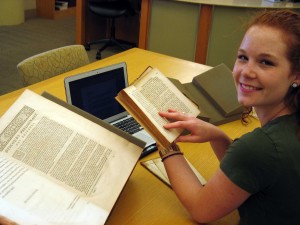ANNOUNCING OUR FALL 2013 CREATIVE FELLOWS!!
 Christina Claxton ’16 was so excited to begin that she was working on her project even before classes started. Initially planning to do something with the French exploration of Canada (having spent 6 weeks at McGill University over the summer doing just that), she was distracted into another project focused on our fabulous first edition of Diderot’s L’Encyclopédie.
Christina Claxton ’16 was so excited to begin that she was working on her project even before classes started. Initially planning to do something with the French exploration of Canada (having spent 6 weeks at McGill University over the summer doing just that), she was distracted into another project focused on our fabulous first edition of Diderot’s L’Encyclopédie.
Christina has started recording her impressions on a blog titled Philologie de L’Encyclopédie, and says, “over the course of the semester, I will work with its volumes as well as related sources to understand both its impact on the time of its publication and how it has influenced present day knowledge and thinking.”
 Maia Madison ’15 intrigued the committee by her desire to create hand-drawn maps tracing the spread of the use if cacao throughout the colonial Spanish Empire. Here is a further description of her ideas:
Maia Madison ’15 intrigued the committee by her desire to create hand-drawn maps tracing the spread of the use if cacao throughout the colonial Spanish Empire. Here is a further description of her ideas:
For those who wonder if she can pull this off, take a look at her “draft” sketch (her words) which I caught a look at in passing! If this is a quick sketch, imagine what the finished products will look like. Here is her plan, viz. the maps:
If this is a quick sketch, imagine what the finished products will look like. Here is her plan, viz. the maps:
Two 1-1/2’ x 2-1/2’ maps (one overall of New Spain, another zoomed in detail of Central America with inset on the layout of cacao orchards) with information on primary and secondary production regions, areas where flavoring agents were cultivated, trading routes, voyages, Spanish settlements, etc.
We look forward to seeing their projects unfold, and to announcing our Spring Fellows in December!



